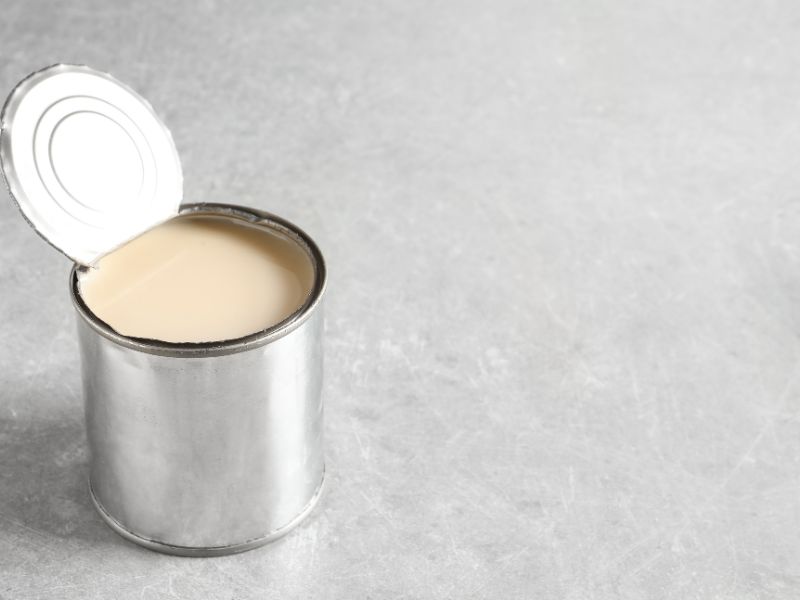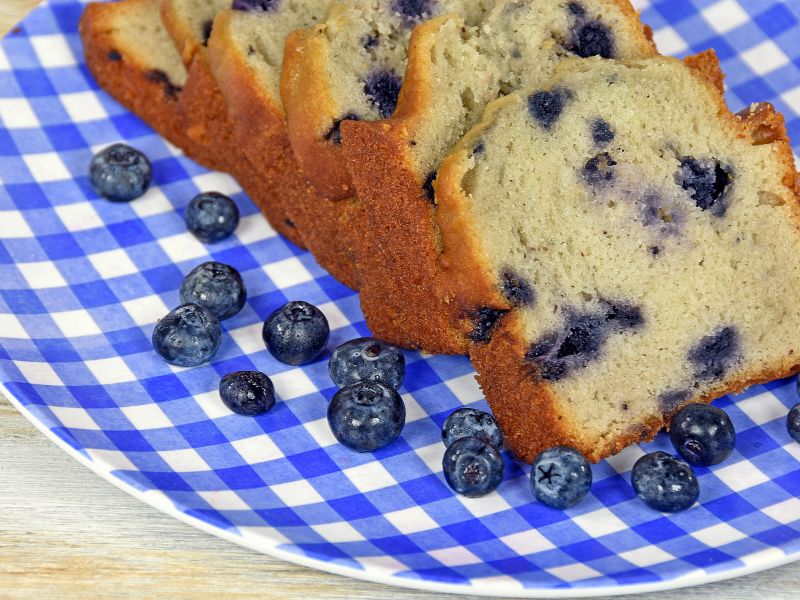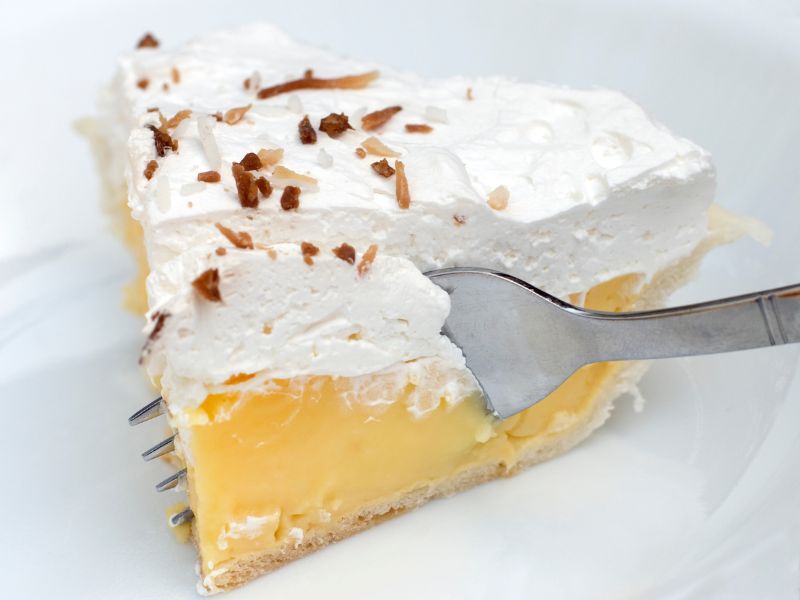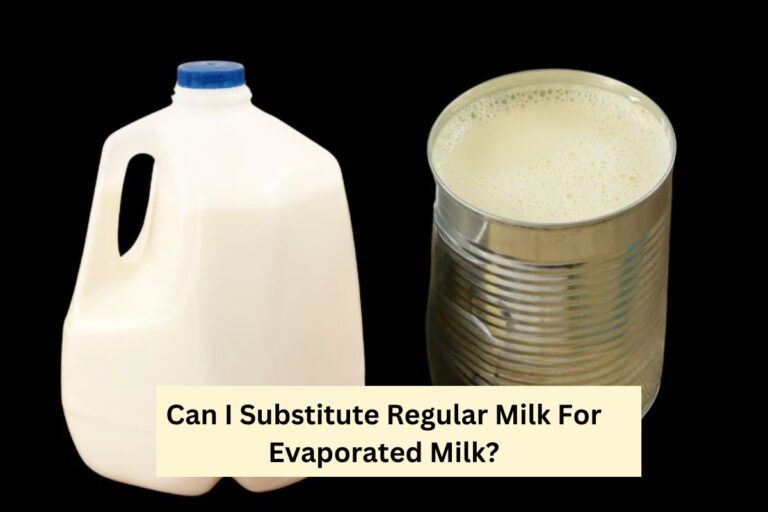Yes, you can substitute regular milk for evaporated milk in a pinch—just know that some slight differences in your baked goods will exist. Evaporated milk has a thicker texture and richer taste due to the water removal process, so substituting thinner regular milk won’t quite copy the density and bold milky flavor of evaporated milk.
- What is Evaporated Milk?
- Can You Substitute Regular Milk for Evaporated Milk?
- How to Substitute Regular Milk for Evaporated Milk
- Tips for Using Regular Milk as a Substitute:
- When is it Okay to Substitute Regular Milk?
- When is it Better to Use Evaporated Milk?
- Frequently Asked Questions
- Key Learning Points:
What is Evaporated Milk?

But first, what exactly is evaporated milk? It starts out the same way as the regular old cow’s milk that is in your fridge. But then about 60% of its water content is removed. This happens by heating the milk so some of the water evaporates (hence the name).
The process leaves evaporated milk nearly double the thickness of regular milk. It also concentrates the natural sugars and proteins, giving it a richer, creamier, and slightly sweeter flavor. When a recipe calls for evaporated milk, it’s for adding creamy texture and milky flavor. It can make things like custards, pies, sauces, and ice creams extra tasty.
Can You Substitute Regular Milk for Evaporated Milk?
You can use regular milk when a recipe calls for evaporated milk. But because it’s thinner with a more subtle flavor, you won’t get quite the same thick ‘n’ creamy outcome as the real deal.
Recipes made with regular milk rather than evaporated milk will often bake up lighter and fluffier. Think delicate cakes rather than dense, fudgy brownies. The taste also won’t be as sweet and milky.
Now that’s not to say using regular milk is a flop! With a couple of adjustments, you can get nice and tasty results. And lighter baked goods have their perks. But just don’t expect the same rich density and strong milky essence as you’d get from evaporated milk.
You can still make tasty baked goods by using the right ratio of regular milk to evaporated milk in recipes and a simple trick to thicken it.
How to Substitute Regular Milk for Evaporated Milk
Replacing evaporated milk with regular milk is straightforward. Just follow this simple ratio:
Use 1 1⁄3 cup regular milk for every 1 cup evaporated milk called for.
To copy evaporated milk’s thick, creamy texture:
Simmer the measured milk over medium heat, allowing it to bubble gently while stirring occasionally. Cook until reduced by about one-third. Remove from heat, let the thickened milk cool completely, then mix into your recipe.
Or make a cornstarch slurry – Mix 1 tablespoon cornstarch with 2 tablespoons cold water until combined. Stir the slurry into the measured milk in a saucepan. Heat slowly, stirring gently, until slightly thickened, then chill before using.
If you want to skip thickening for the sake of convenience and time, that works, too. Just use the 1 1⁄3 cups regular to 1 cup evaporated milk ratio. Your baked goods may turn out a bit more delicate and tender without the thicker consistency. But will still be tasty.
To add some richness back: Use whole milk over low-fat, or stir a little butter or cream cheese into the batter or dough.
Thicken for creamy results closer to evaporated milk, or don’t thicken for a lighter texture. Either way lets you easily replace evaporated milk in your recipes!
👩🍳 Recipe Adjustments for Milk Types 🍲 |
||
|---|---|---|
| Recipe Type | Adjustment with Regular Milk | Expected Outcome |
| Custards, Pies | Use 1 1⁄3 cups regular milk + thicken with cornstarch slurry | Creamier texture, but slightly less rich than with evaporated milk |
| Sauces, Ice Cream | Simmer regular milk to reduce by one-third; consider adding a bit of cream | Close to original texture, with a slightly lighter flavor |
| Cakes, Muffins | Direct substitution with 1 1⁄3 cups regular milk; no thickening needed | Lighter, more tender texture |
| Brought to You by wearebaking.com | ||
Tips for Using Regular Milk as a Substitute:
Do you want your regular milk substitute to shine? Here are some tips.
Use whole milk – The higher fat content makes whole milk closer to evaporated in terms of richness. 2% milk also works in a pinch!
Add a pinch of sugar – Since evaporated milk is slightly sweeter, a teaspoon of sugar stirred into regular milk can come close to that subtle sweet quality.
Give it a taste test – Before baking or cooking your goodies, taste the mixture and see if the thickness, sweetness, or richness needs adjusting at all. Then tweak from there with extras like a pat of butter or a splash of cream.
Check consistency while baking – With pies, custards, or sauces, peek in occasionally as they bake. If needed, thicken some reserved regular milk with cornstarch and stir it in gently if the filling seems too thin.
With a few minor things like choosing whole milk and tasting as you go, regular milk makes a fine stand-in. Then lick the spoon and enjoy your tasty treats!
When is it Okay to Substitute Regular Milk?

You’ll find that swapping regular milk for evaporated milk tends to work nicely when the milk’s role is more subtle rather than vital to your finished baked good.
Regular milk blends in beautifully for things like fluffy pancakes or waffles, muffins, quick breads, and even some tender cakes that just call for a splash of milk. When there are plenty of other bold ingredients or chunky mix-ins, slightly less rich milk flavor goes undetected.
Since these types of baked goods don’t rely on the thick richness evaporated milk gives, using regular milk works well. The slightly lighter and more tender texture you’ll get is actually a welcome result.
So whenever the milk plays a background supporting role, whether cakey treats, breads, or breakfast delights, Regular milk shines as an easy substitute for evaporated milk. Texture and richness don’t make or break these goodies.
When is it Better to Use Evaporated Milk?

While regular milk works in a pinch, some recipes truly depend on evaporated milk’s lush texture and full flavors.
When you spy evaporated milk in recipes for silky puddings, smooth custards, cream pie fillings, or ice cream, it’s there for good reason! Those dishes rely on evaporated milk for a creamy, lush texture and strong milky flavor. The same goes for savory dishes like creamy chowders, soups, and classic sauce recipes.
So when that signature thick, silken, and creamy mouthfeel, along with stronger milk flavor, is central to a recipe, evaporated milk is the star player. You can use regular milk, but the delicate texture and more subtle taste can seem out of place, no matter how well you thicken it.
It’s best to pick up a can of evaporated milk in those cases! It brings something special that no substitute can completely copy.
🍰 Pros and Cons of Milk Substitution 🥛 |
|
|---|---|
| Pros ✅ |
– Regular milk is more readily available – Lighter, fluffier texture in baked goods – Can be thickened to mimic evaporated milk – Works well in recipes where milk is a subtle ingredient |
| Cons ❌ |
– Thinner texture; lacks creaminess of evaporated milk – May result in less rich and milky flavor in finished dishes – Requires adjustments or additional ingredients for optimal results – Not a direct substitute in recipes heavily reliant on evaporated milk’s texture |
| Brought to You by wearebaking.com | |
Frequently Asked Questions
Can I use skim milk or low-fat milk as a substitute?
Skim or low-fat milk can be used, but the lower fat content means your baked goods or dishes may turn out more delicate and less rich than evaporated milk would produce. For best results, use whole or 2% milk and stir in a little extra butter or cream cheese to better mimic the creamy richness.
What if my recipe calls for sweetened condensed milk
Regular milk is not a suitable substitute for sweetened condensed milk.
Can I substitute other dairy alternatives for evaporated milk?
Yes. Good alternatives include half-and-half (1:1 ratio), heavy cream (1:1 ratio, may need to reduce other fats), whole milk yogurt (3/4 cup per 1 cup evaporated milk), condensed milk (3/4 cup per 1 cup evaporated milk), and powdered milk reconstituted with less water. Each will lend thickness and richness similar to evaporated milk but may have slight differences in flavor depending on the dairy used.
Key Learning Points:
- You can substitute regular milk for evaporated milk in a pinch but with some adjustments.
- The consistency and richness of your baked goods may be slightly different.
- You’ll need to thicken the regular milk to achieve a closer texture and taste to evaporated milk.
Have you ever substituted regular milk for evaporated milk? I’d love to hear about your experiences. Please leave me a comment below.
And As Always
Keep On Baking!
Taianne
Share the Love

I’m Taianne, the owner and operator behind We Are Baking. Baking my first cake at age 11 hooked me on creating sweet treats. Though my interest faded during childhood, it was rekindled when I married my apple pie-loving husband. I love trying new recipes, tweaking classics, and helping others learn the science and art of baking. I started We Are Baking to share tips, tricks, and favorite recipes I’ve discovered over the years. When not in the kitchen, I enjoy spending time with family and friends. My goal is to inspire others to embrace their creativity through baking. Feel free to contact me with any questions!
Taianne@wearebaking.com

